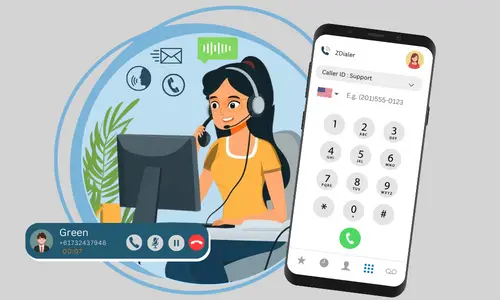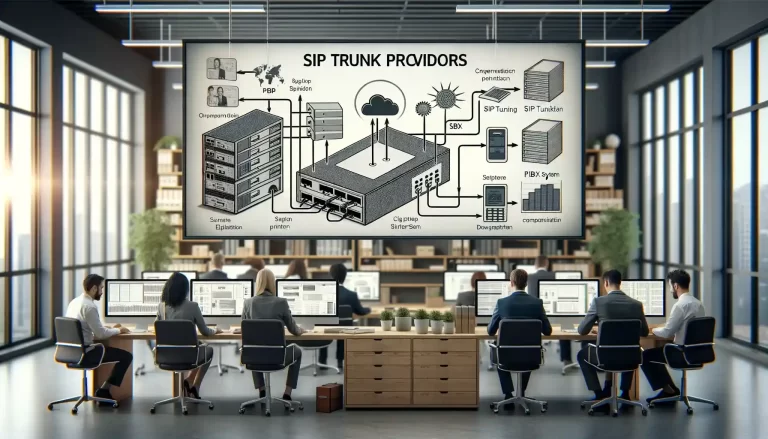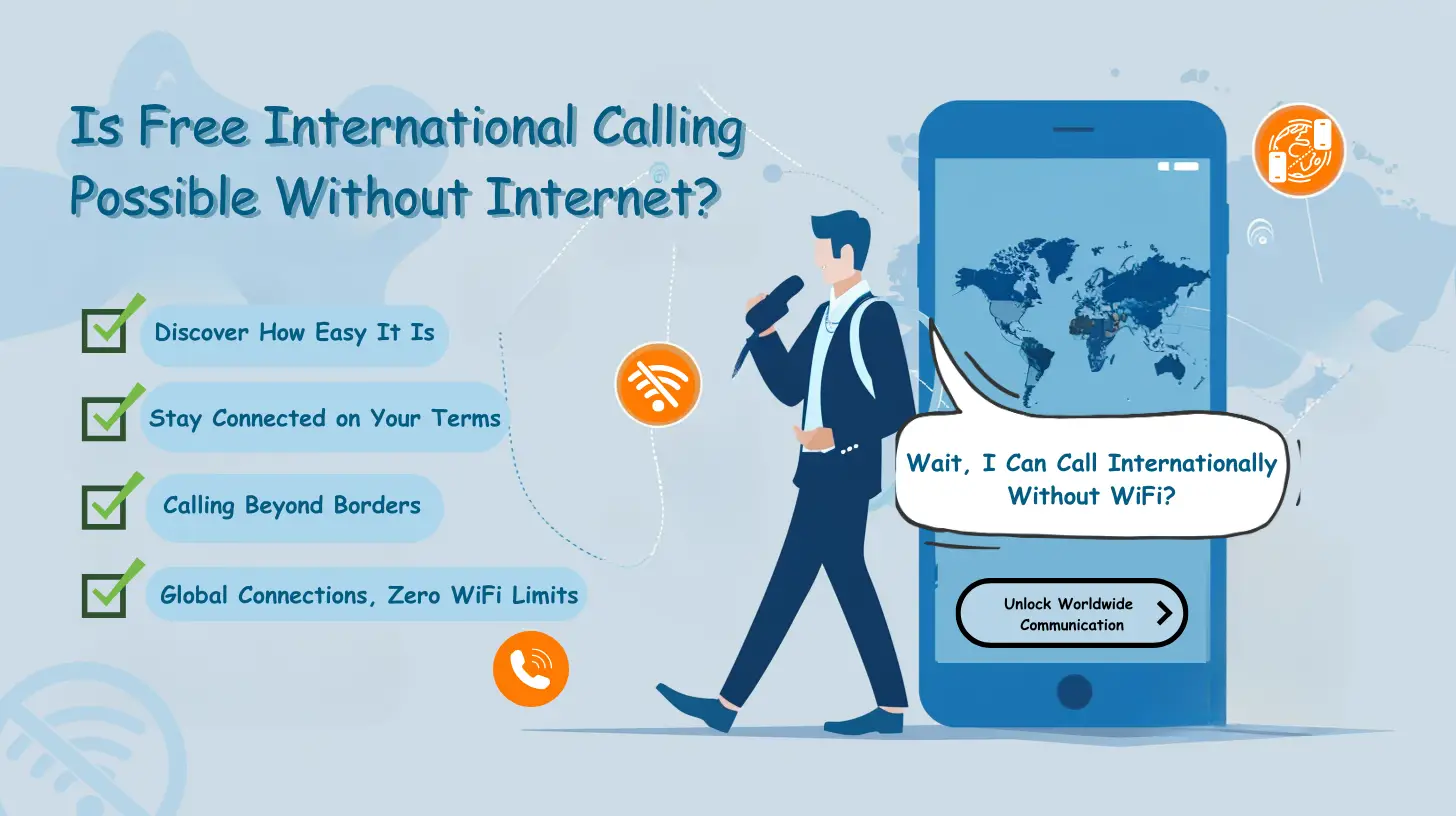Welcome to our expert guide on understanding SIP trunk providers. In today’s digital age, businesses are constantly looking for ways to optimize their communication systems and improve efficiency. SIP trunking services offer a cost-effective and flexible solution for businesses of all sizes. Whether you are a small business or a large enterprise, SIP trunk providers can help you streamline your communication processes and enhance your connectivity.
But what exactly is SIP trunking? How does it work? And what are the benefits of using SIP trunk providers? In this guide, we will answer all of these questions and more, providing you with a comprehensive understanding of this telecommunications technology. Whether you are new to SIP trunking or looking to switch providers, we have got you covered.
At My Country Mobile, we specialize in providing top-notch SIP trunking solutions for businesses. Our affordable SIP trunk providers are dedicated to delivering high-quality communication services tailored to your specific needs. With our reliable and efficient SIP trunking solutions, you can optimize your communication systems and take your business connectivity to the next level.
Key Takeaways:
- Understanding what SIP trunk providers offer and how they can benefit your business
- Exploring the features and advantages of SIP trunking services
- Comparing different SIP trunk providers and finding the best fit for your needs
- Considerations for small businesses looking for affordable SIP trunking solutions
- Steps to get started with SIP trunking and choose the right provider for your business
What is SIP Trunking?
SIP trunking is a revolutionary telecommunications technology that enables businesses to make and receive phone calls over the Internet using virtual phone lines called SIP trunks. Unlike traditional phone lines, which rely on physical infrastructure, SIP trunking leverages the power of the internet and the Session Initiation Protocol (SIP) to transmit voice calls as digital packets. This innovative approach streamlines communication systems and offers numerous benefits for businesses of all sizes.
SIP trunking eliminates the need for traditional phone lines and allows businesses to harness the flexibility and scalability of internet-based communication. By converting analog voice signals into digital packets, SIP trunking enables clear and reliable communication. This technology also supports advanced communication features such as call forwarding, call recording, and interactive voice response (IVR) systems. With SIP trunking, businesses can optimize their communication strategies and improve overall efficiency.

With the rise of remote work and the increasing reliance on cloud-based solutions, SIP trunking has become an essential tool for modern businesses. It offers geographic flexibility, allowing calls to be made from anywhere with an internet connection. Moreover, SIP trunking provides enhanced security measures through encryption protocols to protect data packets transmitted over the internet. This ensures that businesses can communicate with confidence and peace of mind.
Benefits of SIP Trunking:
- Cost savings: SIP trunking helps businesses reduce telephony costs by eliminating the need for traditional phone lines and long-distance charges.
- Scalability and flexibility: SIP trunking allows businesses to easily scale their communication systems as their needs change, whether it’s adding more lines or expanding to new locations.
- Improved reliability: With SIP trunking, businesses can maintain reliable communication even during outages or high call volumes, ensuring uninterrupted connectivity with customers and clients.
- Advanced communication features: SIP trunking provides access to a wide range of advanced features, including call recording, call forwarding, and interactive voice response (IVR) systems, enhancing productivity and customer service.
- Integration with business systems: SIP trunking seamlessly integrates with other business systems such as CRM tools and call center software, streamlining workflows and improving overall efficiency.
- Real-time analytics: SIP trunking offers real-time analytics capabilities, providing businesses with valuable insights into call volumes, patterns, and trends, enabling data-driven decision-making.
- Enhanced security: SIP trunking utilizes encryption protocols to protect data packets transmitted over the internet, ensuring secure and private communication.
- High call quality: By leveraging the power of the internet, SIP trunking delivers high-quality voice calls, providing clear and crisp audio for effective communication.
How Does SIP Trunking Work?
SIP trunking operates by converting analog voice signals into digital packets of data, which are then transmitted over the internet using the Session Initiation Protocol (SIP). When a call is made, the analogue voice signal is first transformed into digital packets. These packets are then sent over the internet to the recipient. At the receiving end, the packets are reassembled into an analogue voice signal, ensuring clear and reliable communication.
To maintain call quality, Quality of Service (QoS) protocols prioritize voice traffic. This prioritization ensures that voice packets are given higher priority and are delivered with minimal delay or packet loss. Additionally, encryption protocols are used to protect the data packets during transmission, ensuring the privacy and security of communications.
SIP trunking leverages the existing internet connection of a business, eliminating the need for separate telephone lines. This technology allows businesses to optimize their communication systems by utilizing their existing infrastructure while benefiting from the flexibility and cost savings offered by SIP trunking.

Call Flow in SIP Trunking
Understanding the call flow in SIP trunking is essential to grasping how the technology operates. Here is a simplified overview:
- A user places a call from their SIP-enabled device or phone.
- The voice signal is converted into digital packets and transmitted over the internet using the SIP protocol.
- The SIP trunk provider receives the packets and routes them to the appropriate destination.
- The recipient’s SIP-enabled device or phone receives the packets and reassembles them into an analogue voice signal.
- Both parties can then engage in clear and reliable communication.
This call flow ensures that businesses can make and receive voice calls seamlessly using SIP trunking, utilizing the power of the internet for efficient and cost-effective communication.
Comparison of Traditional Phone Lines and SIP Trunking
When it comes to communication systems for businesses, there are two main options: traditional phone lines and SIP trunking. Let’s take a closer look at the differences between the two and why more and more businesses are choosing SIP trunking over traditional phone lines.
Cost Savings and Scalability
SIP trunking offers significant cost savings compared to traditional phone lines. With traditional phone lines, businesses often pay for individual lines and maintenance costs, which can add up quickly. In contrast, SIP trunking allows businesses to consolidate their communication channels and only pay for the number of channels they actually need, resulting in lower monthly costs.
Additionally, SIP trunking provides scalability options that traditional phone lines do not. Businesses can easily add or remove channels as their needs change, without the need for physical installations or significant downtime.
Flexibility and Location-Dependent Calls
One of the key advantages of SIP trunking is its flexibility. With traditional phone lines, businesses are tied to specific physical locations. SIP trunking, on the other hand, enables businesses to make and receive calls from anywhere with an internet connection. This is especially beneficial for remote workers or businesses with multiple locations.
Moreover, SIP trunking eliminates the need for location-dependent calls. With traditional phone lines, businesses may incur additional charges for long-distance or international calls. SIP trunking allows businesses to make these calls at a fraction of the cost, as they leverage the internet for communication.
Enhanced Communication Features and Integration
While traditional phone lines offer basic calling functionality, SIP trunking provides access to a wide range of advanced communication features. These features include call forwarding, call recording, interactive voice response (IVR), and more. Such features can greatly enhance business communication and improve customer service.
Furthermore, SIP trunking allows for seamless integration with other business systems, such as CRM tools or call center software. This integration enables streamlined workflows, efficient call routing, and real-time analytics, resulting in improved productivity and better decision-making.
Improved Reliability
SIP trunking offers improved reliability compared to traditional phone lines. With traditional phone lines, businesses may experience disruptions and downtime due to physical line damage or maintenance issues. SIP trunking, being virtual and internet-based, is less susceptible to such issues. In the event of an outage, calls can be automatically rerouted to alternative lines or devices, ensuring uninterrupted communication for businesses.
By considering the cost savings, scalability, flexibility, location-independent calling, communication features, integration capabilities, and improved reliability, it becomes clear why businesses are increasingly opting for SIP trunking over traditional phone lines.

Benefits of SIP Trunking
SIP trunking offers a range of benefits for businesses, making it a popular choice for optimizing communication systems. Let’s explore some of the key advantages:
- Cost savings: SIP trunking can significantly reduce communication costs by eliminating the need for traditional phone lines and long-distance charges. Businesses can consolidate their voice and data services into one network, resulting in substantial savings.
- Scalability: With SIP trunking, businesses can easily scale their communication systems up or down to match their evolving needs. Adding or removing lines is quick and straightforward, providing the flexibility required in today’s dynamic business environment.
- Flexibility: SIP trunking allows businesses to connect multiple locations and remote employees seamlessly. It enables geographically dispersed teams to collaborate effectively and efficiently, fostering better communication and productivity.
- Improved reliability: SIP trunking offers enhanced reliability compared to traditional phone lines. It leverages redundant connections and failover systems to ensure uninterrupted communication, even in the event of an internet outage.
- Advanced communication features: SIP trunking provides access to a wide range of advanced communication features, such as call forwarding, voicemail-to-email transcription, interactive voice response (IVR) systems, and video conferencing. These features enhance collaboration and streamline business processes.
- Integration with business systems: SIP trunking can integrate seamlessly with other business systems, such as customer relationship management (CRM) software, call centre platforms, and unified communication solutions. This integration enables businesses to improve efficiency and enhance customer service.
- Real-time analytics: With SIP trunking, businesses can access real-time analytics and reporting on call volume, call durations, and other key metrics. This data provides valuable insights for optimizing communication strategies and improving customer interactions.
- Enhanced security: SIP trunking employs encryption protocols to protect voice data transmission, ensuring the confidentiality of sensitive information. This added layer of security minimizes the risk of data breaches and unauthorized access.
- High call quality: SIP trunking delivers high-definition voice quality, providing crystal-clear communication for both internal and external calls. Businesses can enjoy a professional and reliable calling experience, enhancing customer satisfaction.
Overall, SIP trunking offers significant advantages for businesses looking to streamline their communication systems, reduce costs, and enhance productivity. By harnessing the power of the internet and advanced technologies, businesses can unlock the full potential of their communication infrastructure.

Integration and Advanced Features of SIP Trunking
Integration with business systems is a key advantage of SIP trunking. By connecting phone systems with other business tools, such as CRM software or call centre platforms, businesses can streamline workflows and enhance customer service. This integration allows for efficient call routing, ensuring that calls are directed to the appropriate departments or agents, minimizing wait times and improving customer satisfaction. Furthermore, with seamless data synchronization between different systems, businesses can access real-time information and provide personalized and relevant customer experiences.
When it comes to advanced communication features, SIP trunking offers a wide range of capabilities. Call forwarding enables calls to be redirected to different numbers or devices, ensuring that important calls are never missed. Call recording allows businesses to capture and store important conversations for training, quality assurance, or compliance purposes. Interactive voice response (IVR) systems offer automated menus and prompts, allowing callers to navigate through options and reach the right department or information without the need for human intervention.
Overall, the integration and advanced features of SIP trunking contribute to increased efficiency, productivity, and customer satisfaction. By seamlessly connecting phone systems with other business tools and leveraging advanced communication features, businesses can optimize their operations and deliver exceptional experiences to their customers.
Table: Comparison of SIP Trunking Features
| Feature | Description |
|---|---|
| Integration with business systems | Allows phone systems to integrate with CRM software, call centre platforms, and other business tools to streamline workflows and enhance customer service. |
| Efficient call routing | Ensures that calls are directed to the appropriate departments or agents, minimizing wait times and improving customer satisfaction. |
| Seamless data synchronization | Enables real-time access to information across different systems, providing personalized and relevant customer experiences. |
| Call forwarding | It redirects calls to different numbers or devices, ensuring important calls are never missed. |
| Call recording | Captures and stores important conversations for training, quality assurance, or compliance purposes. |
| Interactive voice response (IVR) | Provides automated menus and prompts for callers to navigate through options and reach the right department or information. |
SIP Trunks vs SIP Channels
In a SIP trunking system, SIP trunks and SIP channels are key components that determine the capacity and functionality of the communication network. Understanding the difference between the two is essential for businesses considering the adoption of SIP trunking.
SIP trunks are the virtual phone lines that enable businesses to make and receive calls over the internet using the Session Initiation Protocol (SIP). Each SIP trunk consists of one or more SIP channels, with each channel representing an inbound or outbound call. The number of channels needed depends on the number of concurrent calls a business expects to handle at any given time.
The virtual installation and flexibility of SIP trunks make them a cost-effective and scalable solution for businesses. Instead of relying on physical phone lines, SIP trunks leverage the internet for connectivity, allowing for easy expansion as the communication needs of the business grow. With SIP trunks, businesses can optimize their communication systems and streamline their operations.
Comparison between SIP Trunks and SIP Channels
| SIP Trunks | SIP Channels |
|---|---|
| Virtual phone lines are used for making and receiving calls over the internet | Represent individual inbound or outbound calls within a SIP trunk |
| The number of trunks determines the maximum number of concurrent calls | The number of channels determines the maximum number of concurrent calls |
| Flexible, can be easily scaled up or down based on business needs | Flexible, can be easily scaled up or down based on business needs |
| Eliminates the need for physical phone lines | Virtual connections that utilize the internet for connectivity |
By understanding the difference between SIP trunks and SIP channels, businesses can make informed decisions about their communication infrastructure. SIP trunking provides a flexible and cost-effective solution for businesses of all sizes, allowing them to maximize their communication capabilities and adapt to changing needs.
Why are Businesses Using SIP Trunking?
SIP trunking has become increasingly popular among businesses for several reasons.
- Cost savings: One of the main benefits of SIP trunking is the potential for significant cost savings. By using virtual phone lines over the Internet, businesses can eliminate the need for traditional phone lines, which can be expensive to maintain and upgrade.
- Geographic flexibility: SIP trunking allows businesses to make and receive calls from anywhere with an internet connection. This flexibility is particularly beneficial for companies with remote or distributed teams, as it eliminates the need for physical phone lines in multiple locations.
- Future preparedness: As technology continues to evolve, traditional phone lines are becoming outdated. SIP trunking provides businesses with a future-proof communication solution that can easily adapt to changing needs and advancements in the telecommunications industry.
- Control: With SIP trunking, businesses have more control over their communication systems. They can easily scale up or down their phone lines based on their needs, add or remove features as required, and have greater visibility and control over call analytics.
- Unified communications: SIP trunking enables businesses to integrate their phone systems with other communication tools, such as video conferencing and instant messaging, creating a unified communications platform that enhances collaboration and productivity.
- Quick set-up: Implementing SIP trunking is generally quick and straightforward. Businesses can easily set up and configure their virtual phone lines, allowing them to start making and receiving calls in a short amount of time.
Overall, SIP trunking offers businesses a cost-effective, flexible, and future-ready solution for their communication needs.

Table: Comparison of SIP Trunking Benefits
| Benefits | Description |
|---|---|
| Cost savings | Eliminates the need for traditional phone lines, reducing costs |
| Geographic flexibility | Allows businesses to make and receive calls from anywhere with an internet connection |
| Future preparedness | Adaptable to changing technology and industry advancements |
| Control | Greater control over phone system scalability, features, and analytics |
| Unified communications | Integration with other communication tools for enhanced collaboration |
| Quick set-up | The easy and efficient implementation process |
What is Elastic SIP Trunking?
When it comes to advanced communication solutions, elastic SIP trunking is a game-changer. This cloud-based virtual solution offers businesses the flexibility, scalability, and integration they need to optimize their communication systems. By leveraging the power of the cloud, elastic SIP trunking provides seamless connectivity and enhanced features that enable businesses to stay connected, regardless of their location or device.
With elastic SIP trunking, businesses can enjoy a wide range of advanced features that go beyond traditional phone systems. These features include call forwarding, call recording, interactive voice response (IVR), and more. This allows businesses to streamline their workflows, provide efficient customer service, and ensure seamless data synchronization across different business systems.
Integration with cloud communication services is another key advantage of elastic SIP trunking. By integrating with services such as unified communications platforms, businesses can create a unified and comprehensive communication system. This enables employees to access their communication tools from anywhere, using any device and ensures a consistent and efficient communication experience for both internal and external stakeholders.
Elastic SIP trunking offers businesses the flexibility to adapt and scale their communication systems as needed. Whether it’s adding new phone lines or expanding to new locations, Elastic SIP trunking can easily accommodate changing business needs. This scalability eliminates the need for costly infrastructure upgrades and allows businesses to stay agile and responsive in today’s fast-paced business environment.
In summary, Elastic SIP trunking is a cloud-based virtual solution that provides businesses with advanced features, flexibility, and integration with cloud communication services. It empowers businesses to optimize their communication systems, streamline workflows, and enhance customer service. With its scalability and reliability, Elastic SIP trunking is the future of business communication, enabling businesses to stay connected and competitive in today’s digital landscape.
How Much Does SIP Trunking Cost?
SIP trunking offers numerous benefits for businesses, but one important consideration is the cost. The pricing for SIP trunking can vary depending on several factors. Here are some key components to consider when evaluating the cost of SIP trunking:
- Monthly Subscription: SIP trunking providers typically offer different subscription plans based on the number of simultaneous calls a business needs. The monthly subscription cost will depend on the specific plan chosen and the number of channels required.
- Outbound Calling Rates: Some providers may charge additional fees for outbound calls made using SIP trunking. These rates can vary depending on the destination of the call and the provider’s pricing structure.
- Add-ons: Certain features or services may be considered add-ons and come with an additional cost. Examples of add-ons may include call recording, advanced analytics, or additional security measures.
- Set-up Fees: Some providers may charge a one-time set-up fee to activate SIP trunking services for a business. This fee can vary depending on the provider and the complexity of the setup process.
It’s important for businesses to carefully evaluate their communication needs and budget when considering SIP trunking. Comparing pricing plans and features offered by different providers can help determine the most cost-effective solution for your business.
Overall, the cost of SIP trunking can vary depending on the specific requirements of your business. It’s recommended to consult with a reliable provider like My Country Mobile to discuss your needs and obtain a customized quote that aligns with your budget and communication goals.

How to Get SIP Trunking?
Getting SIP trunking for your business is a straightforward process that offers a range of options to meet your specific needs. Whether you prefer to sign up online, make a call to the provider, or fill out a contact form, there are several ways to get started with SIP trunking.
To sign up online, visit the website of a reliable SIP trunking provider like My Country Mobile. Look for a dedicated page or section that offers information on their SIP trunking services. You will typically find details about the features, pricing plans, and sign-up process. Fill out the online form, providing the necessary information about your business, communication requirements, and contact details. Once submitted, a representative from the provider will usually get in touch with you to discuss your specific needs and guide you through the next steps.
If you prefer a more personal approach, you can call the SIP trunking provider directly. Look for their contact information, such as a phone number, on their website. Make the call and express your interest in their services. A knowledgeable representative will be available to answer your questions, explain the sign-up process, and provide any additional information you may need. This direct communication can help ensure that all your concerns are addressed and that you have a clear understanding of what to expect from the SIP trunking service.
Alternatively, if you prefer to provide your information in writing, you can fill out a contact form on the SIP trunking provider’s website. Look for a “Contact Us” or “Request More Information” page. Fill in the required details, including your name, email address, phone number, and a brief message about your interest in SIP trunking. Submit the form, and a representative will typically reach out to you via email or phone to discuss your requirements and guide you through the next steps.
Conclusion
In conclusion, SIP trunking is a game-changing telecommunications technology that provides numerous benefits for businesses. By replacing traditional phone lines with virtual lines or trunks, businesses can make and receive phone calls over the Internet using the Session Initiation Protocol (SIP). This technology offers cost savings, scalability, flexibility, and improved reliability for businesses of all sizes. With advanced communication features, integration with business systems, real-time analytics, and enhanced security measures, SIP trunking allows businesses to optimize their communication systems.
The benefits of SIP trunking are vast. It offers cost savings by eliminating the need for physical phone lines and reducing long-distance charges. It provides scalability, allowing businesses to easily add or remove trunks as their communication needs change. SIP trunking also offers geographic flexibility, enabling businesses to make calls from anywhere with an internet connection, and future preparedness by embracing the latest communication technology.
When it comes to getting SIP trunking for your business, there are various options available. You can sign up online, call the provider directly to discuss your specific needs or fill out a contact form to request a demo or more information. Pricing for SIP trunking varies depending on factors such as monthly subscription plans, outbound calling rates, add-ons, and set-up fees. It is important to carefully consider your calling needs and budget when choosing a SIP trunking service.
Overall, SIP trunking is a cost-effective and efficient solution for businesses looking to improve their communication systems. With its benefits, ease of integration, and flexibility, SIP trunking is revolutionizing the way businesses communicate. To get SIP trunking for your business, reach out to a reliable provider like My Country Mobile and explore the possibilities it offers.




























